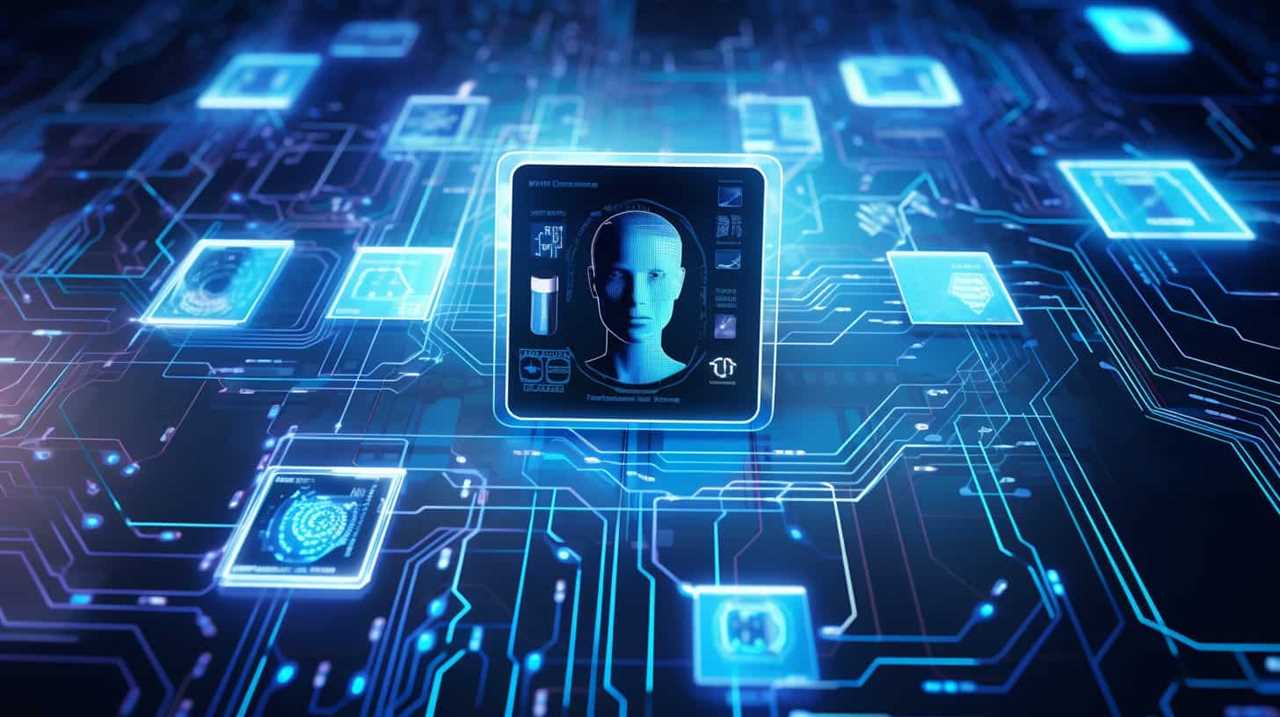As an expert in AI security, I firmly believe that AI is transforming the way we safeguard data.
Did you know that 95% of cybersecurity breaches are due to human error? But fear not, because AI is here to help.
With its advanced capabilities, AI can detect and prevent cyber threats in real time, providing a new level of security for your valuable data.
In this article, I will explore how AI is your data’s new best friend, unlocking its power to safeguard against emerging risks and enhance privacy.
Key Takeaways
- AI continuously monitors and analyzes potential threats, minimizing the risk of data breaches and ensuring the integrity and confidentiality of sensitive information.
- AI-powered systems detect and prevent cyber threats by analyzing network traffic and identifying abnormal behavior within networks, enabling quick response and minimizing potential damage.
- AI security systems employ adaptive threat detection mechanisms, continuously monitoring and analyzing network traffic, user behavior, and system logs to identify potential risks before they cause harm.
- AI enhances data privacy by automatically encrypting data, implementing robust access controls based on user behavior patterns, and automating the identification and anonymization of personally identifiable information (PII), helping organizations comply with privacy regulations and protect individuals’ data.

The Role of AI in Data Security
In my experience, AI plays a vital role in ensuring the security of data through its ability to continuously monitor and analyze potential threats. With the advancement of machine learning algorithms, AI-powered threat detection has become more efficient and effective in safeguarding valuable information.
Machine learning algorithms enable AI systems to learn from vast amounts of data, allowing for the identification of patterns and anomalies that may indicate a security breach. By constantly monitoring network traffic, AI can swiftly detect and respond to any suspicious activities or threats. This proactive approach minimizes the risk of data breaches and ensures the integrity and confidentiality of sensitive information.
AI’s ability to analyze and interpret complex data sets empowers organizations to stay one step ahead of cybercriminals, making it an indispensable tool in today’s data-driven world.

Detecting and Preventing Cyber Threats
AI’s role in detecting and preventing cyber threats is crucial for safeguarding valuable data. In today’s digital landscape, where cyberattacks are becoming increasingly sophisticated, organizations need advanced tools to defend against potential threats.
Here are four key ways in which AI, along with cybersecurity automation and machine learning algorithms, enhances the detection and prevention of cyber threats:
- Real-time threat monitoring: AI-powered systems continuously monitor network traffic and analyze patterns, enabling the identification of potential threats in real-time.
- Anomaly detection: Machine learning algorithms can detect abnormal behavior within networks, flagging potential cyber threats that may have gone unnoticed by traditional security measures.
- Predictive analytics: AI can analyze vast amounts of data to identify trends and patterns, helping organizations anticipate and proactively address emerging cyber threats.
- Rapid response and mitigation: AI automation enables quick response to cyber threats, reducing response times and minimizing potential damage.

Real-time Response to Emerging Risks
To effectively respond to emerging risks in real-time, I rely on the power of AI security and its ability to analyze and adapt to potential threats. AI security systems employ adaptive threat detection mechanisms, which continuously monitor and analyze network traffic, user behavior, and system logs to identify any anomalies or suspicious activities.
This proactive risk management approach enables the AI system to identify potential risks before they can cause any harm. By leveraging machine learning algorithms, AI security can learn from past incidents and constantly update its threat models to stay ahead of emerging risks.
This real-time response capability is essential in today’s rapidly evolving threat landscape, where new vulnerabilities and attack vectors are constantly being discovered. With AI security, I can have peace of mind knowing that my data is protected with the most advanced and responsive defense mechanisms available.

Enhancing Data Privacy With AI
How can AI enhance data privacy while responding to emerging risks in real-time?
AI-driven privacy solutions are revolutionizing data privacy by providing advanced techniques to protect sensitive information. Here are four ways AI is enhancing data privacy:
- AI-powered data encryption: AI algorithms can automatically encrypt data, ensuring that it remains secure even if it falls into the wrong hands.
- Intelligent access controls: AI can analyze user behavior patterns and detect suspicious activities, enabling organizations to implement robust access controls and prevent unauthorized access to data.
- Anomaly detection: AI algorithms can identify abnormal patterns in data access and usage, alerting organizations to potential security breaches or data misuse.
- Privacy-enhancing technologies: AI can automate the identification and anonymization of personally identifiable information (PII), helping organizations comply with privacy regulations and protect individuals’ data.

Leveraging AI for Future Data Protection
As an AI security solution, my role is to leverage advanced technologies and algorithms for future data protection.
One of the key ways in which AI can enhance data protection is through AI powered encryption. This involves using AI algorithms to automatically encrypt sensitive data, making it more secure and less susceptible to unauthorized access. AI powered encryption can analyze patterns and identify potential vulnerabilities, enabling organizations to proactively protect their data.
Another important aspect of leveraging AI for future data protection is AI driven anomaly detection. By continuously monitoring and analyzing data, AI algorithms can detect abnormal patterns or behaviors that may indicate a security breach or unauthorized access. This enables organizations to respond quickly and effectively to potential threats, minimizing the impact on their data security.

Frequently Asked Questions
How Does AI Technology Impact the Speed and Accuracy of Detecting Cyber Threats?
AI technology greatly enhances the speed and accuracy of detecting cyber threats. By analyzing vast amounts of data in real-time, AI algorithms can quickly identify patterns and anomalies, allowing for rapid threat detection and response.
Can AI Solutions Provide Real-Time Response to Cyber Threats Without Human Intervention?
Can AI solutions provide real-time response to cyber threats without human intervention? Absolutely! AI algorithms can continuously monitor and analyze data, swiftly detecting and responding to threats, ensuring immediate protection for your systems.
What Specific Measures Can AI Take to Enhance Data Privacy and Protect AgAInst Breaches?
To enhance data privacy and prevent breaches, AI can implement robust encryption algorithms, monitor network traffic for suspicious activity, analyze user behavior patterns, and automatically respond to potential threats in real-time.
How Does AI Leverage Machine Learning Algorithms to Predict and Prevent Future Cyber Attacks?
AI leverages machine learning algorithms to predict and prevent future cyber attacks. It constantly learns and adapts to new threats, analyzing vast amounts of data to identify patterns and anomalies, enhancing security measures.
What Are the Potential Limitations or Challenges of Implementing AI for Data Protection in Organizations?
Implementing AI for data protection in organizations presents several limitations and challenges. These include the need for extensive training data, potential biases in algorithms, and the constant need for updates and maintenance to keep up with evolving cyber threats.

Conclusion
In the realm of data security, AI has emerged as a powerful ally, protecting our valuable information from cyber threats. With its ability to detect and prevent attacks, respond in real-time, and enhance data privacy, AI has become our data’s new best friend.
Just as a shield safeguards a knight in battle, AI shields our data, ensuring its safety and enabling us to leverage its power for future protection.
Together, we conquer the digital world, armed with the strength of AI security.









